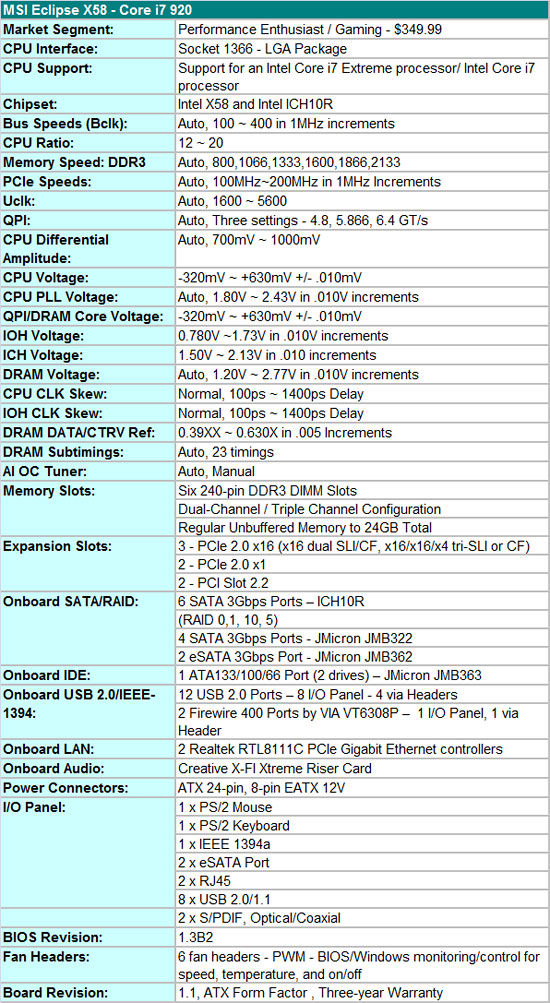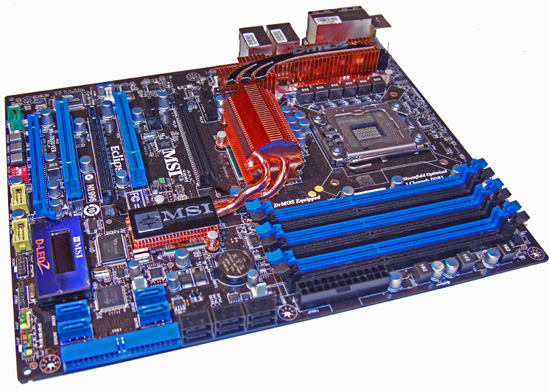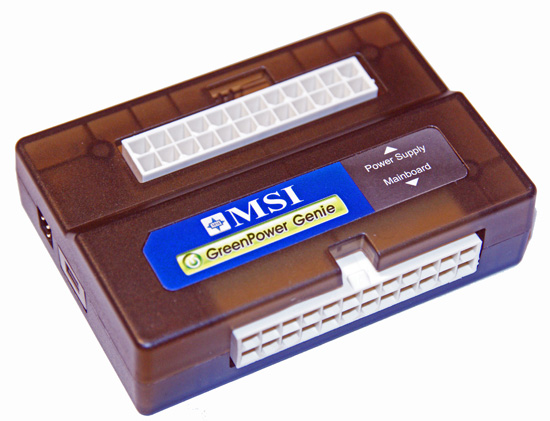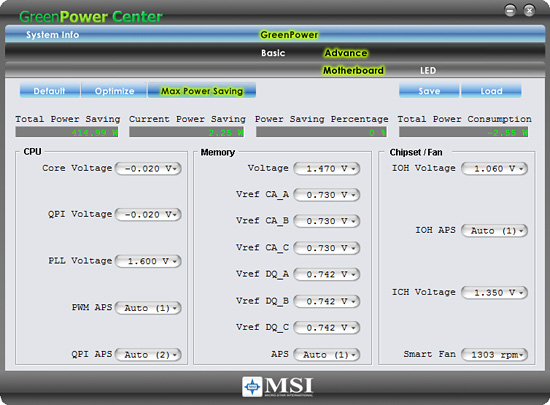Intel X58 Motherboard Roundup - What does $300 Get You?
by Gary Key on December 5, 2008 3:00 PM EST- Posted in
- Motherboards
MSI Eclipse X58
Features

The MSI Eclipse X58 is a feature laden board from a hardware and software viewpoint. It should be considering the $350 price tag, although there is a $30 mail-in-rebate at present. The almost universal Realtek RTL-8111C PCIe Gigabit Ethernet controllers are utilized in tandem; a riser card featuring the Creative Lab's CA0110-IBG chipset provides HD audio and EAX 5.0 capabilities; JMicron’s JMB 363/362/322 chipsets are tabbed for eSATA, IDE, and additional SATA port duties; VIA's VT6308P provides IEEE 1394a support; and the Intel ICH10R is utilized for primary storage purposes.
The BIOS is designed for overclocking duties, although it's not as comprehensive as those from ASUS or Gigabyte. However, it is fair to say that several of the options that ASUS and Gigabyte provide will never be touched by about 95% of us when overclocking. Our main knock against the BIOS is that it is not as user friendly as the others in this roundup. We do not care for the +/- voltage settings as it becomes confusing for the user to understand exactly what effect their changes had on the particular option, especially without knowing what the base voltage is set at.
MSI supports stock memory speeds up to 2133MHz on the i920/i940 processors along with opening up QPI link speeds from a standard 4.800 GT/s up to 6.400 GT/s, which is standard on the i965 Extreme processor. The board fully supports 24GB of DDR3 memory. We have a 24GB kit arriving shortly for testing so we cannot confirm compatibility yet, but we trust MSI in this regard.
In the meantime, we have not had any problems running 12GB with our Patriot or G.Skill DDR3-1600 kits up to 1600 at 9-8-8-24 1T timings, although we needed about 1.68V for absolute stability with the i920 at stock speeds. Dropping the command rate to 2T allows 1.64V operation with the current BIOS. Overall, memory performance is very competitive with the other boards and improving in each BIOS release. However, this is the only six slot board that we have been unable to clock a 12GB configuration up to a 191x21 setting. The board stops around a 175 Bclk with an 8x memory multiplier that results in a DDR3-1528 speed. The board will clock up to a 191 Bclk with the memory multiplier at 6x, which results in a DDR3-1146 setting. MSI is working on improving this area.
The Eclipse board contains three PCI Express 2.0 x16 slots that operate in x16/x16 mode for 2x SLI/CF. The third x16 slot operates in x4 mode regardless of the second slot population. 3x SLI/CF configurations run in x16/x8/x8 mode on the EVGA and Gigabyte boards. We did not notice any performance differences between the x16/x16 or x16/x8 operation in 2x CF with our HD 4870 cards. However, we just received a new BIOS from MSI that allows 3X SLI/CF to operate properly. We will update the article in a few days with a comparison between the boards utilizing all three x16 slots. We had no problems running our ASUS Xonar D2X or Highpoint Rocket RAID cards in slots two or three.
The Board


The Eclipse X58 is MSI's current flagship board with the recently introduced Platinum X58 filling a void in the low end X58 market with a $220 price tag. While $220 is an awful lot for a motherboard, it's practically a bargain in this particular market sector. Of course, you give up a few items like SLI compatibility, an additional x16 slot, and the JMicron SATA ports, but for a lot of users those features are not that important.
MSI went a different direction with this board compared to earlier designs; gone is the roller coaster or circular heatpipe design, as is the traditional fire engine red color scheme that is now a subdued black and blue color palette. While colors do not determine the performance of a board, they do tend to make a difference in first impressions. We like the new color scheme and sincerely appreciate a more traditional heat pipe setup. In fact, MSI skipped on an elaborate heatpipe setup found on other boards and concentrated on cooling the voltage circuitry separately, although the northbridge and southbridge are still linked together.
The CPU area is fairly open and our larger air coolers did not pose a problem. The Eclipse board features a two-phase power delivery system for the northbridge and for the memory subsystem. A six-phase power delivery design is utilized for the processor, half that of the Gigabyte and ASUS boards. However, this did not adversely affect the overclocking capabilities of the board. MSI utilizes high quality solid-state capacitors and ferrite core chokes on the board.
The general layout is very good as MSI has managed to situate the vast number of ports, slots, and hardware in a manner that keeps them from interfering with installed peripherals. MSI managed to squeeze three PCI Express 2.0 x16 slots (x16/x16/x4), two PCIe x1 slots, and two PCI slots. This arrangement allows 3X Crossfire or SLI and still leaves a single PCIe x1 slot open. However, using a double slot card in the third slot will make it extremely difficult to utilize the power, reset, IEEE 1394a, and USB ports. Our opinion about 3X CF/SLI is not that high unless you are benchmarking for 3DMark records, so we appreciate the fact that a 2X CF/SLI arrangement will leave a PCIe x1, PCI, and PCIe x16 (x4 electrical) slot open.
On the bottom of the board you will find onboard buttons for power, reset, and the D-LED 2 display module. The D-LED 2 is handy for a quick glance during the POST process or you can have it display VCore or northbridge voltages along with pinpointing a particular temperature on the board with the included 20" probe. The D-LED does not display hex codes, instead relying on short hand messages like "DDR Ini" during post processes.
While we appreciate the D-LED, it is really only good for windowed cases or open platform testing. We think MSI should have included an attachment cable that allowed placement outside of the case. Also, the unit does not live up to its potential by providing additional hardware monitoring capabilities such as temperatures, fan speeds, or other voltage readings. Of course, MSI has monitoring software that accomplishes these tasks, but we think a hardware solution would be better, especially considering the cost of the board.
The IO panel features eight USB 2.0 ports, two Ethernet jacks, an IEEE 1394a port, and two eSATA ports courtesy of the JMB 362 chipset. MSI also includes an expansion slot backplate that allows an additional two eSATA ports via any of the board's internal SATA connections. An audio output panel is missing since MSI utilizes a riser card that features Creative Lab's CA0110-IBG audio chipset.
Our first reaction was very positive until we looked at the chipset specifications and realized that hardware audio processing capabilities - including the EAX 5.0 implementation - are done through software and the CPU. Also, most of the software features from a standalone X-FI card are not available in the software package that MSI provides. They did include access to Creative's 24-bit Crystalizer and speaker virtualization features along with other hardware settings.
Of course the big question is the audio quality provided by this solution. RightMark Audio Analyzer indicated poor THD and inter-channel leakage, but in actual usage we could not tell any real differences between the Creative and Realtek solutions in music playback quality. The ADI solution on the ASUS board sounded a bit clearer and dynamic in music playback. In gaming, we thought the Creative solution was slightly better than the ADI chipset and noticeably better than the Realtek solutions on the Gigabyte and EVGA boards. If gaming or music playback is a priority, we still suggest an add-in card for best performance.
The Application


MSI features a unique power saving system on the Eclipse. They include a GreenPower Genie pass-through connector that attaches to the 24-pin ATX power supply cable and a cable that attaches to the 24-pin ATX connector on the motherboard. There is also a two-pin cable that attaches to the Genie and the motherboard that works in conjunction with the the GreenPower software to monitor and dynamically reduce power usage.
This system will automatically scale the number of active power phases for the processor, memory, and northbridge. We noticed savings of 9W at idle, so it actually works. In fact, it provides better results than the ASUS EPU-6 or Gigabyte DES power saving systems. During testing, it was able to switch fast enough so we did not have to worry about program crashes when utilizing GreenPower. The one drawback is that the pass-through connector and cable is a bit cumbersome to use in smaller cases.
















78 Comments
View All Comments
belladog - Saturday, December 6, 2008 - link
Im glad Anandtech is taking a firmer stance with the motherboard makers. I too have seen a degradation in quality over the years.I take what review sites say with a grain of salt. People concerned about stabilty should go to the motherboards makers forums(or other user forums) to really see what to expect with a product.
You dont need to be einstein to realise that manufacturers send hand picked and tweaked products to review sites. Their sales figures depend on a good review, but then the masses who buy the boards/products from the shop see very different results.
Also its hard to poorly rate a product when reviewers have friendships at the companies or depend on advertising revenue from these same companies.
Whats the use of high overclocks if you cant get 4 Gigs of ram to work? Or your new PCI-E 2.0 Video card is having "compatibilty" problems with a board advertised to run it? Then they say its your PSU or memory. The PSU maker blames the motherboard, everyone blames each other and us suckers have to go out and buy 2 PSU's, 2 different ram kits and mix and match to get a working system.
I like to buy high end parts but my experience is its usually not worth it. Most "high end" boards, PSU's , memory are overpriced and provide little or no better experience than a mainstream parts at half the price, except maybe graphics cards where a high priced one will provide a better gaming experience on high settings.
Even in crossfire/SLI an X38/X48 board running at 16X/16X will perform no better than a mainstream P45 board running at 16X/8X. Even worse in some situations.
X58 is a little different because its a whole new architecture that looks interesting but really doesnt offer a huge performance gain. We will probably see the socket 1156 boards performing about the same if the past is anything to go by.
Anyway something needs to change in regards to reviews. Maybe review sites should only test parts obtained from retail channels. Maybe review sites should run a standardised lot of tests before even considering overclocking results. I expect all the advertised features to work correctly as advertised.
Like i said, the best thing consumers can do is, dont take too much notice of reviews and go to the manufacturers forum or other user forums to see what you're really in for.
stungun - Saturday, December 6, 2008 - link
I love the fact you are trying to implement changes in how you review hardware. Personally I do not overclock, dont want to but i do want the newer Intel processor/motherboard combo for 3d rendering and just because it is time to upgrade I should go with the future. Not all your readers want to burn up cpu components some of us just want a good honest working system.shocku - Saturday, December 6, 2008 - link
That's it?!After promising snippets for weeks, the final article is a compilation of what's been said before. That, and more promises future articles will be more in-depth about: RAM… non ES CPUs… the two or three X58 motherboards not covered here…, etc., etc., etc.
I appreciate all the work that goes on behind the scenes to make reviews. But at some point you gotta tell it like it is. If a BIOS or driver wasn't ready-- tough luck. There's plenty of room for other companies to shine by getting things right the first time. Or, are sites like Anandtech the new beta testers?
"We still have several boards to review, ranging from the $220 MSI Platinum up to the $400 Foxconn Bloodrage with several in-between. Our next review will focus on the "lower" end X58 boards from Intel, Gigabyte, Biostar, and MSI. Our final review will feature the upper end boards from ASUS, Gigabyte, DFI, and Foxconn. In between, we will provide a comprehensive OC guide along with a detailed look at memory performance with several DDR3 tri-channel kits from Corsair, OCZ, Patriot, GSkill, Kingston, Crucial, and Mushkin."
Say it isn’t so. Why did I read this article for?
I'll try going from the bottom up...
>I thought the Nehalem memory article was out already. There's that much memory performance left to be covered?
>How can readers make use of "a comprehensive OC guide" that's coming out before "upper end boards"? There's no point if a few bucks more can get you a board that goes as high as your attempts to OC the cheaper one. Might as well pay more and OC more, or pay less if both have the same ceiling.
>The next review will be about lower end boards like Intel's?! Huh?! The Smackover retails for over $250 USD. Unless they have a cheaper board nobody knows about, and they're ready to sell it now; there's NO SUCH THING as a low end X58 board this year.
This article's conclusion, as of 12/05/08, seems impartial and has constructive criticism for the board makers. Perhaps this whole series of articles and blogs will look good to someone reading them for the first time 6 months from now. But, right now, the article is just fodder.
Are readers better off with an expensive board they know thanks to this article, or should they get an even more expensive board that’s been skipped from this review? Heck, maybe the best is a cheaper one whose price puts it in the so-called ‘low end.’
These boards are not $1-$5 dollar items. So, say it like you mean it.
KTHX.
Or... charge manufacturers for all the beta testing you've done and the many 'second' chances they got before you went public. While you're at it, spare us from dealing with ads in your Web site.
PS: I wrote this before I read any comments. Boy am I not alone!
sidewinderx2 - Saturday, December 6, 2008 - link
Err... i'm pretty sure i'm just feeding a troll here... but here goes:Do you not understand what quotation marks mean? You know... somewhat sarcastic? they specifically put the word "lower" in quotation marks, so unless you truly have no grasp of the english language, you must be retarded to think that they actually meant those boards are "low end" boards.
"This article's conclusion, as of 12/05/08, seems impartial and has constructive criticism for the board makers. Perhaps this whole series of articles and blogs will look good to someone reading them for the first time 6 months from now. But, right now, the article is just fodder. "
So... what you're saying is... "WAAAAH! ANANDTECH DIDN'T TELL ME WHAT I SHOULD BUY! WAAAAH! THEY'RE TOO IMPARTIAL! WAAAH! THEY SHOULD BLINDLY GIVE ADVICE OVER THINGS THEY HAVEN'T TESTED YET! WAAAAAAAAH!"
Right.
LtPage1 - Friday, December 5, 2008 - link
Which companies have better quality control out of the gate is information of EXTREME relevance to the consumer. These boards are close enough together in pricing, features, and performance as makes no difference to me. Which company's board had the least problems when it was shipped to you would absolutely sway my purchase. Also, how quickly they dealt with problems you brought up, and how obsessed they were with overclocking performance results to the exclusion of basic functionality would be a huge factor for me.Inform the consumer! Report on hardware? Tell us which companies deserve our money.
chekk - Friday, December 5, 2008 - link
Perhaps you should send the mobo manufacturers a bill for your testing. It sounds like Anandtech provided a very valuable service since clearly the manufacturer's quality assurance processes are not up to the task.Yes, overclocking is fun, but if I buy a production board, it had better be production ready. Also, whether the board is $300 or $65, that sucker better work.
I'd actually like to know which manufacturers we're discussing as I'd like to stop supporting them with my dollars until they get a clue.
Ben - Friday, December 5, 2008 - link
It's hard not to rant here, but I know that rants often get passed over.You guys don't know what a relief it was to read this article. I've been building systems for many years and I have noticed the steady decline in quality.
My latest build was not only the most money I've ever spent on a computer, but also the worst experience I've ever had with a build. I've since sold it off as pieces, while I contemplate buying a preassembled workstation for the first time in my life.
The final straw for me was when I complained about a broken feature to a well-known manufacturer and they told me that I "should have known" what to expect from their product by reading their message boards. In other words, we know it says it does A, B, and C on the box, but if you read our message boards before you bought our product, then you would have known that it doesn't do A, B, and C.
I hope you guys can turn this situation around.
DBissett - Friday, December 5, 2008 - link
Anand's essay on this topic is some of the most important writing I've seen here. Unfortunately, the editorial slant of AT reviews, along with many other sites, has set the stage over the years for exactly what the complaint is about. Anand describes it well...the overriding interest, if not outright obsession, with what often amounts to miniscule performance advantages has literally buried the benefits of simple day to day dependability. Now that this situation has reached such extremes that Anand feels compelled to sound off about it, the task is to turn the editorial focus enough to raise dependability to the higher level of concern that it deserves. Some users in the forums point out at times that different settings or product differences make absolutely no difference in real world use. AT reviews should be equally candid and state, perhaps in bold type, when differences in observed speed are insignificant, and then NOT go on to rank order products on these insignificant speed differences. AT reviews should also go on to provide a rating or at least clear observations about the true ease of use, dependability and satisfaction to be expected by users in general or at different levels of experience, including BIOS issues that the manufacturer has not fixed. It sounds like this might be coming. Great! JDPowers ranks cars on something like initial problems/defects found by new buyers and there's no reason why similar polling/experiences shouldn't be provided for users of what are increasingly expensive computer parts. I hope Anand follows up on this issue and really institutes changes to address it.marsrunner - Friday, December 5, 2008 - link
Thanks for the roundup. Great reading.I bought the i7-920, 12GB of G.Skill PC3-1333 RAM and Asus P6T a couple of weeks ago, and have only had one real problem. My new Logitech Illuminated Keyboard causes the mobo to take about 3 minutes to initialize USB devices at POST, and then when it does POST the keyboard won't work at all until Vista takes over. Very irritating. Haven't contacted ASUS, because I'm sure they'd point the finger at Logitech, who would point the finger back at ASUS. Besides, the keyboard does not cause any problems on my other PC.
I should say that I don't and won't be doing any overclocking, unlike most people around here I imagine, but even so I've noticed a lack of attention to detail in these mobos.
Ecmaster76 - Friday, December 5, 2008 - link
Good article.However the feature tables are a rather large download. If you absolutely must post them as an image please use PNG or GIF. I resaved one in both formats and the size dropped in half without a loss in quality. JPEG is excellent where color content is more important than detail. However the indexed color of PNG and GIF is superior for a 2 color text table where the sharpness of the letters and not the exact shades of those two green is most important.
Also you have a next page link at the bottom of the last page that, of course, goes nowhere.